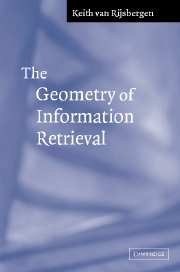Book contents
- Frontmatter
- Contents
- Preface
- Prologue
- 1 Introduction
- 2 On sets and kinds for IR
- 3 Vector and Hilbert spaces
- 4 Linear transformations, operators and matrices
- 5 Conditional logic in IR
- 6 The geometry of IR
- Appendix I Linear algebra
- Appendix II Quantum mechanics
- Appendix III Probability
- Bibliography
- Author index
- Index
5 - Conditional logic in IR
Published online by Cambridge University Press: 14 January 2010
- Frontmatter
- Contents
- Preface
- Prologue
- 1 Introduction
- 2 On sets and kinds for IR
- 3 Vector and Hilbert spaces
- 4 Linear transformations, operators and matrices
- 5 Conditional logic in IR
- 6 The geometry of IR
- Appendix I Linear algebra
- Appendix II Quantum mechanics
- Appendix III Probability
- Bibliography
- Author index
- Index
Summary
We have established that the subspaces in a Hilbert Space are in 1:1 correspondence with the projectors onto that space, that is, to each subspace there corresponds a projection and vice versa. In the previous chapters we have shown how subsets and artificial classes give us a semantics for rudimentary retrieval languages. What we propose to do next is to investigate a semantics based on subspaces in a Hilbert space and see what kind of retrieval language corresponds to it. In particular we will be interested in the nature of conditionals.
To appreciate the role and value of conditionals in IR we look a little more about how they arise in the application of logic to IR. When retrieval is modelled as a form of inference it becomes necessary to be explicit about the nature of conditionals. It is simplest to illustrate this in terms of textual objects. A document is seen as a set of assertions or propositions and a query is seen as a single assertion or proposition. Then, a document is considered relevant to a query if it implies the query. The intuition here is that when, say, q is implied by document Δ, then Δ is assumed to be about q. Although retrieval based on this principle is possible, it is not enough. Typically, a query is not implied by any document leading to failure as in Boolean retrieval. To deal with this a number of things can be done.
- Type
- Chapter
- Information
- The Geometry of Information Retrieval , pp. 62 - 72Publisher: Cambridge University PressPrint publication year: 2004



